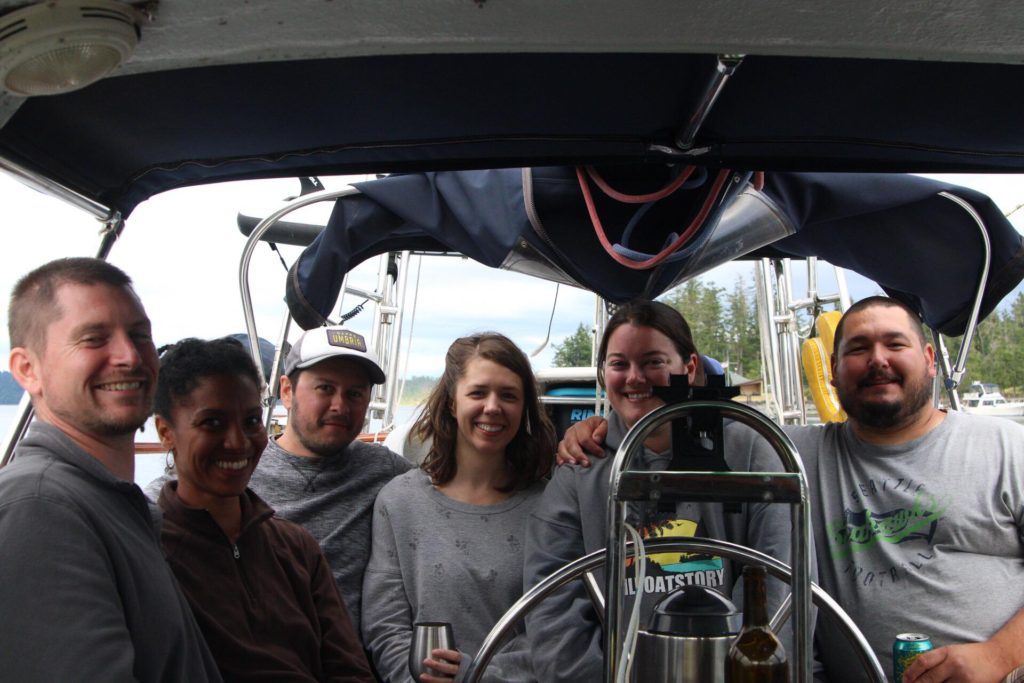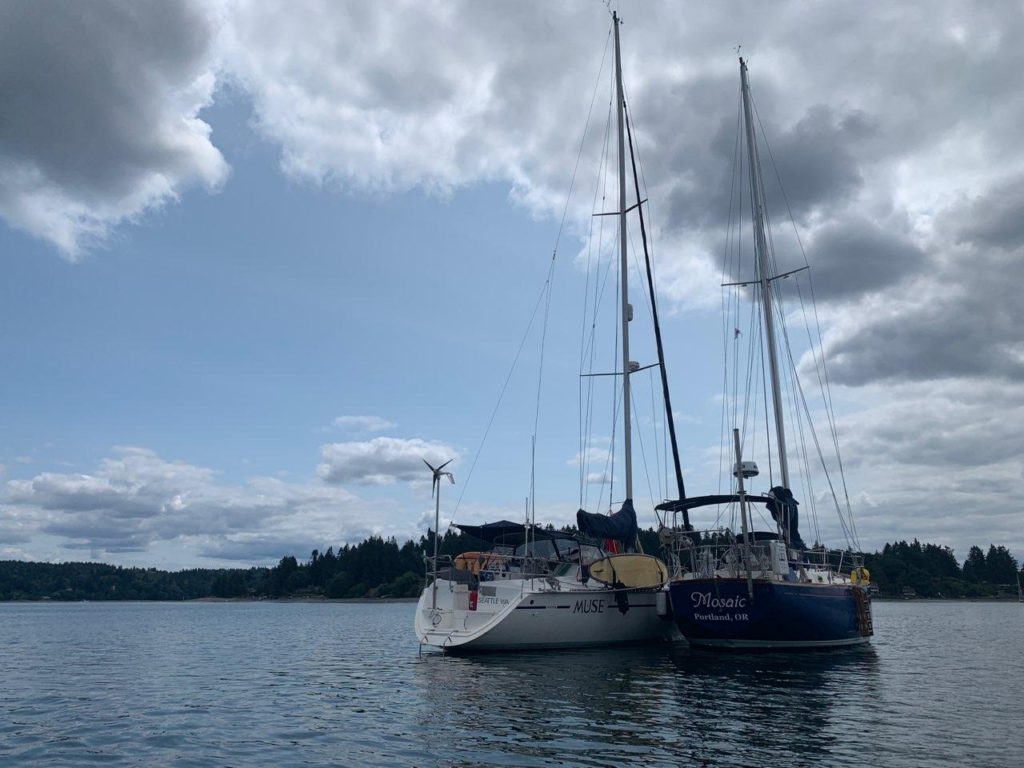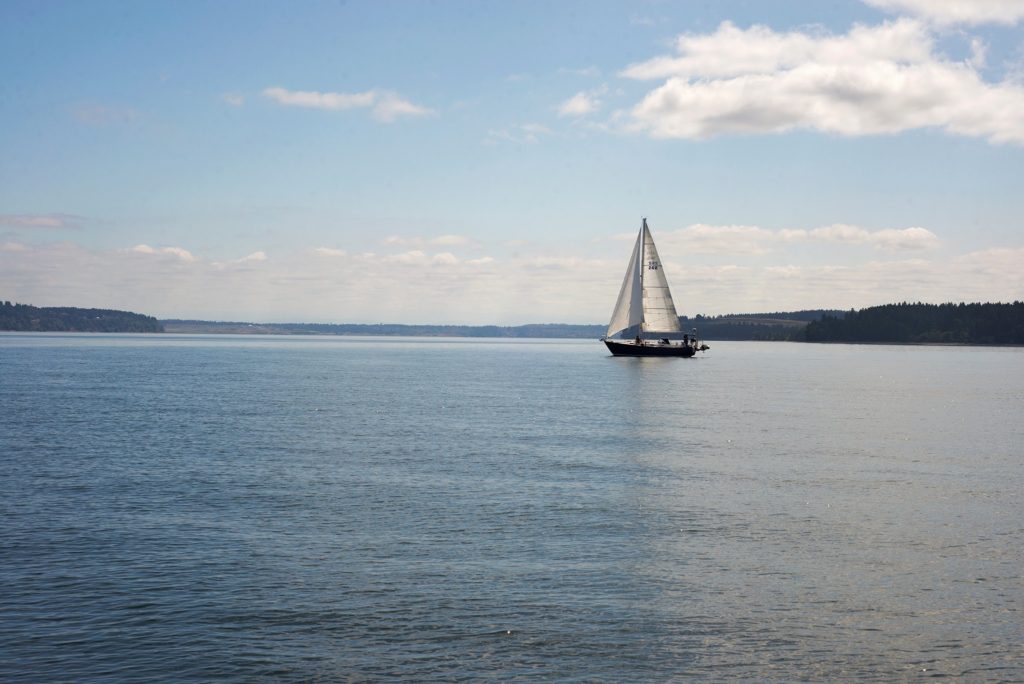This article was previously written by Rachel Messerschmidt for and published by Vancouver Family Magazine in February 2021.
2019 was a year of highs and lows for our family aboard our 40-foot sailboat, Mosaic, in the Pacific Northwest. By the time summer rolled around, we had surpassed a major goal in getting the boat, our home, moved north from the Columbia River to the expansive waters of the Puget Sound. Five years of effort and struggle had finally paid off. We’d made it.
My husband and I both had jobs that allowed us to work remotely. We were homeschooling our kids on the boat. We didn’t have a home port anywhere in the Puget Sound. Our adventuring was only limited by the constraints for work – we just needed to be some place every day that had good enough cell signal to connect to the internet for work.
The world was our oyster, or so it seemed. But on arrival in Seattle at the end of May, our alternator was completely shot. We spent a few weeks in a marina there getting settled into our new life, working on the engine and alternator, and planning our summer adventures.
Finally, toward the end of June, we were ready to leave the safety of the nest in Seattle. We’d replaced several components of the engine, and even had the alternator rebuilt; it seemed to be working. This was a pretty important element as the alternator functions to charge the boat’s battery banks any time that the engine is running. Without being in a marina, we didn’t have readily available access to shore power to charge our batteries, and we need to keep our batteries charged to keep the boat’s systems functioning smoothly and to be able to power our laptops for work.
We had a rough plan in mind to head from Seattle toward the south sound to explore our way all the way to Olympia. After a week at Blake Island Marine State Park just southwest of Seattle, we made plans with two other boats, Muse and Captain Musick, to meet in Oro Bay at Anderson Island. This would be our first time anchoring Mosaic and it felt like a big step – in 3 years aboard the boat, we’d never before spent a night away from the safety and security of being tied to a dock overnight.
It was glorious. It was everything we hoped it would be. We solidified friendships, adults and kids alike, that have held true to this day. Seeing the boats resting happily at anchor, free of the dock, able to move with the wind and water – it was emotionally uplifting for me. That weekend gave us a taste of what cruising could really be like: the self-reliance, the freedom, the exploration and fun with friends.
After waving farewell-for-now to our new friends, we headed further south to a marina in Olympia for the work week and then turned around and headed back north again to Gig Harbor and then to Quartermaster Harbor at Vashon Island for the Fourth of July weekend. We met up with Muse again and spent the holiday weekend rafted up at anchor. Rafting up, the practice of having two or more boats tied together while hanging on, usually, just one anchor, was great fun and made socializing between the boats easy and accessible. The fireworks show was incredible with an amazing display launched from a barge in the harbor – we had front row seats! It was spectacular.
But a series of boat troubles quickly knocked us back down a few pegs when engine issues arose again at the end of the weekend and, on top of that, our anchor windlass died in a glory of sparks shot off the bow. The anchor windlass helps to raise the anchor from the seabed back up to the bow of the boat. With that out of order and our engine overheating, we limped back to Gig Harbor and into a slip at one of the marinas there to assess the full situation.
We spent a couple weeks in Gig Harbor which, it turns out, is a lovely little town and very friendly to boaters. They’ve got a nice bus system and downtown trolley for easy access around town without a car, and lots of outdoor watersport and marine shops. When our troubleshooting on the windlass motor proved fruitless, we were able to purchase a used manual anchor windlass at a small fraction of the price we would have had to pay for a new, electric motorized windlass. The decision meant we’d be getting a workout every time that we raise anchor in the future, but with additional engine problems arising we opted for the cheaper option.
From Gig Harbor, we headed back south to Olympia to have a mechanic take a look at Mosaic’s engine. It was overheating at times, the alternator worked only intermittently and seemed to be in decline again, and we were hearing concerning sounds from the engine block itself. It was time for a professional opinion.
Unfortunately, the crushing news came that the engine would likely fail in the near future. When we’d purchased the boat in 2016, we’d gambled on the engine. It was the original engine from 1978. We knew that we would end up replacing it at some point, we had just hoped that it would hold out longer than it did. We also ended up spending several thousand dollars replacing our batteries and much of the wiring on the boat.
So, with the alternator dying and our engine on its last leg, we purchased a small generator to get us through to the end of the season. Being able to use the generator helped us stay out of marinas, which are expensive, and we were bleeding money and looking ahead at a $35,000 engine replacement. With our tow insurance paid up in case the engine gave out, we struck out in the fall for the San Juan Islands.
Determined to enjoy the rest of the fall, we spent most of September and the first half of October exploring the beauty that is the San Juan Islands near the Canadian border. The islands are spectacular to visit and being able to spend that time there on our boat was magical.
We arranged for our engine replacement in Port Townsend in late October and spent much of that time staying with family in Vancouver. By early November of 2019, Mosaic was back in the water, complete with a shiny new Yanmar engine, and we took her to Poulsbo in the central Puget Sound for winter moorage.
It’s said that the cruising life is full of higher highs and lower lows, and that was certainly true for our first season as nomads in the Pacific Northwest. But it’s important to recognize that everybody struggles when you first transition to a new way of life. It’s just part of the story. And that story, for us, was preparation for all that 2020 would bring, and more.
Rachel Messerschmidt and her family are Clark County natives currently living and cruising full time aboard their sailboat, Mosaic, in the Pacific Northwest and preparing to leave for Mexico in the fall. Rachel blogs about her life and journey at www.mosaicvoyage.com and shares her family’s adventures in a monthly column in Vancouver Family Magazine.






Thank you! Yes, we’re very happy with our new engine – though I suppose it is not quite so new anymore now, having come all the way to Mexico from the PNW. 😂 But she’s been reliable and we’re glad to have an engine we can trust. ~Rachel
Great stories, love to read them. Glad you have a new engine will last for many years. Jim E